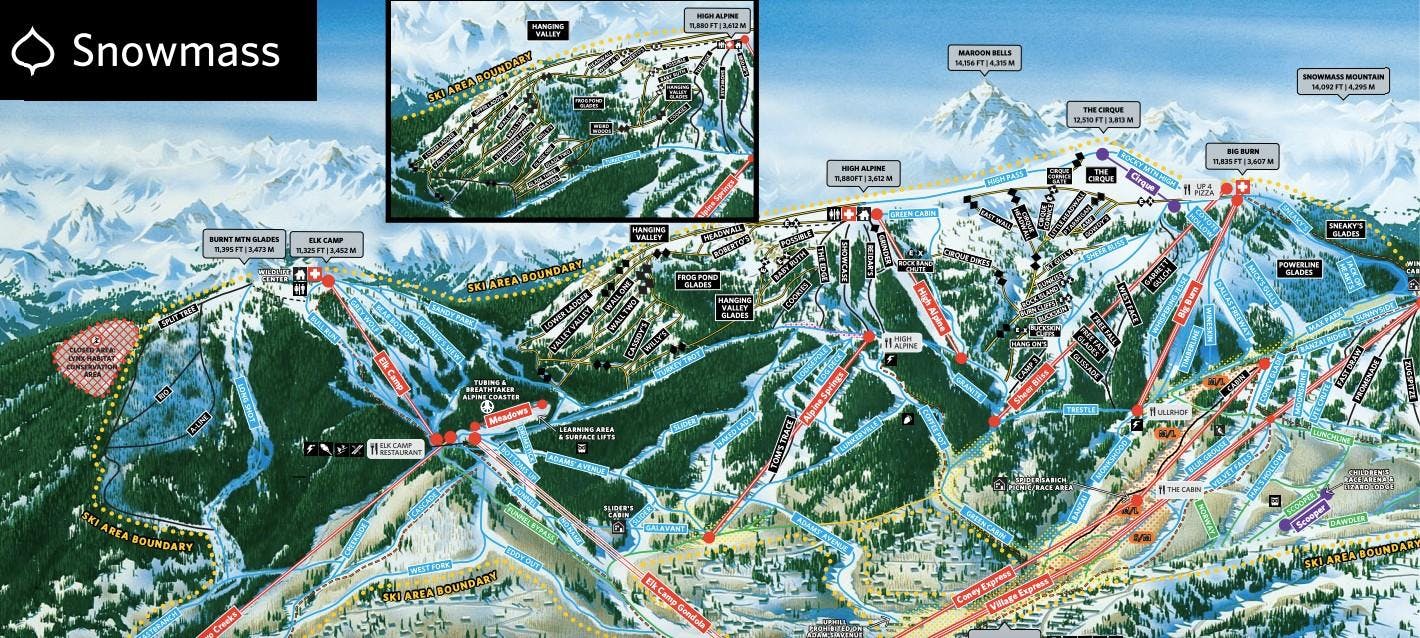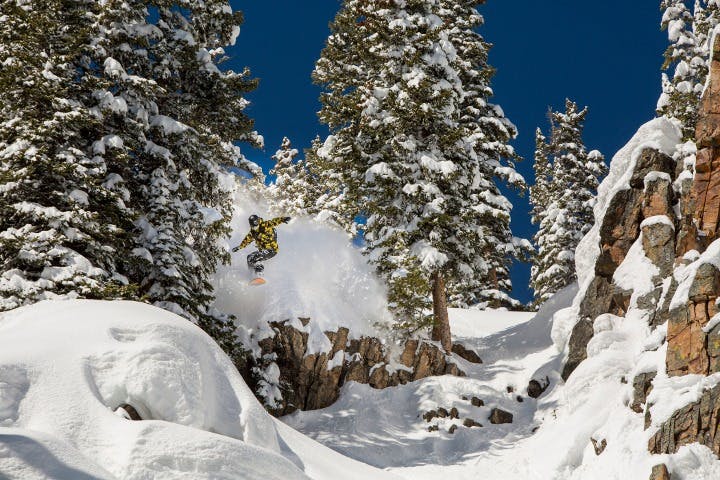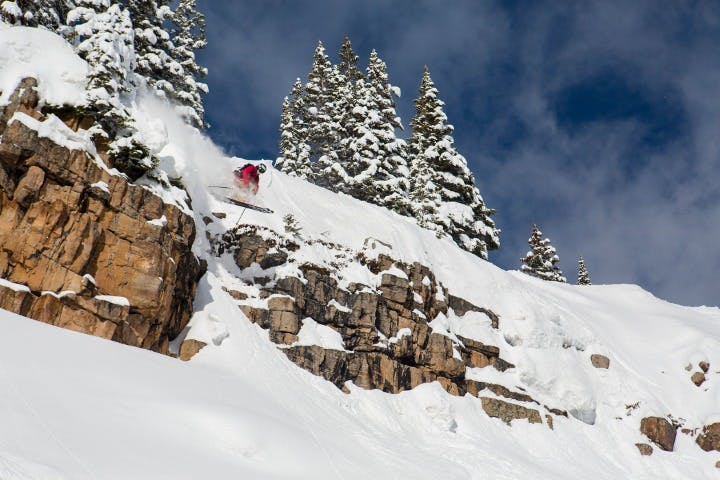
While Snowmass is often celebrated for its family-friendly vibe (with gentle green and blue cruisers galore), it’s also one of Aspen Snowmass’ best-kept secrets for expert skiers and riders. That’s because Aspen Snowmass is home to four unique ski resorts—Aspen Mountain, Aspen Highlands, Buttermilk and Snowmass—that cater to all levels of skiers and riders. And at Snowmass, 47% of the 1,566 acres of skiable terrain is rated advanced to expert, with a significant portion of high-alpine runs designated as extreme. From the legendary Hanging Valley Headwall to the Burn Cliffs in the Cirque, Snowmass offers some of the steepest, most technical lines in the valley and has even hosted big mountain competitions on these very slopes.
Related Reading: The Perfect Aspen Snowmass Itinerary
If you’re chasing untouched powder stashes, spicy steeps or want to add a little edge to your family ski trip, Snowmass’ black and double black-diamond zones deliver the goods. Just be ready to earn your turns – many of these expert areas require a hike and demand solid fitness and advanced skills. Access is only permitted through designated gates, and since these zones require additional avalanche control work, they often open later in the day. To help you make the most of Snowmass’ expert terrain, we tapped longtime ski patroller Kevin “Delfo” Delves for insider tips on his favorite expert and extreme lines in the Cirque, High Alpine and Hanging Valley.

Explore More: Aspen Snowmass Trail Maps
Before diving into the steep and deep, it’s smart to get the legs primed with a few warm-up laps. Start your day on the eastern side of the resort and work your way west as you ramp things up. Snowmass ski patroller Kevin “Delfo” Delves recommends Powderhorn, accessed from the top of Sam’s Knob.
“It offers fun rolling mogul terrain and provides some of the best views down into the Snowmass Creek drainage and the always impressive Mt. Daly,” says Delfo.
On your way toward the Cirque, take a lap on the Big Burn lift for another solid warm-up run. Garrett Gulch features some great advanced terrain and is perfect for readying the legs before tackling the mountain’s more serious lines.

At 12,510 feet, The Cirque is the highest point at Snowmass, and a must-hit for expert skiers and riders chasing extreme terrain. Accessible via ten different gates, the Cirque and neighboring Burn Cliffs offer a variety of aspects, technical lines and serious vertical. Whether you’re looking for wide-open steeps, tight chutes or mandatory airs, this zone stands out on top. AMF is Delfo’s favorite.
“AMF is especially awesome in the spring because of its eastern exposure. It warms up sooner,” says Delfo.
For the steepest shot across all four Aspen Snowmass mountains, head to Gowdy's, just skier’s left of AMF.
“Here, you have to navigate a steep cornice; it’s less consequential on skier’s left or you can turn it into a hefty huck on the right side,” says Delfo.
The nearby Burn Cliffs offer some of the most extreme open terrain in the state, featuring tight, technical chutes and mandatory airs ranging anywhere from 10 to 40 feet.
Right down the gut of the Cirque lies Cirque Headwall, the highest run across the entire resort, offering the top access point into this massive expert-only zone. After your drop-in, the run flows into a mix of glades, open rolling pitches and playful pillow lines like Rock Island, eventually funneling you back to the bottom of the High Alpine lift.
Want a sneak peek? Check out this video from the 2008 Colorado Freeride Championships to see what this famous terrain is all about.
The High Alpine zone lives up to its name, delivering steep black runs, expert-only terrain and jaw-dropping views from the top of the High Alpine lift. Right out of the gate, you’ll find yourself standing above Roberto’s, the widest chute on Snowmass. If you hike a bit farther, you’re above the Hanging Valley Headwall, says Delfo.
This expert zone can also be accessed via the High Pass Traverse, which starts at the top of the Cirque lift. From there, you can drop into either Hanging Valley Proper (head left) or continue along the boundary to reach the Hanging Valley Wall. To get the adrenaline coursing, Delfo’s top picks in the High Alpine zone are Possible and Baby Ruth.
“Possible is an exposed chute through the cliff band, and Baby Ruth offers more of a gladed chute experience,” says Delfo.
 Hanging Valley | Photo: Jeremy Swanson/Aspen Snowmass
Hanging Valley | Photo: Jeremy Swanson/Aspen Snowmass“The Hanging Valley is a huge piece of terrain that takes years to learn,” says Delfo. “I have been working here for five years and never skied the same line twice.”
From the Headwall gate, West 1 and West 2 offer exposed, committed ramps of snow that wind their way through a rock band.
“There are some definite no-fall zones above cliffs that do get hucked from time to time,” says Delfo.
If you traverse just above the Hanging Valley Headwall, you can schuss East 1 and East 2, which are a couple of fun shots separated by a few sparse trees.
“East 1 and 2 will drop into a large parcel of rolling glades, where you’ll find some favorites like Frog Ponds, XYZ Lines and Hanging Valley Dikes," says Delfo.
From the top of the Headwall, veer right to access Dragon’s Tooth Ridge, a dramatic spine of terrain that leads to some of the most committing lines on the mountain. You can peel off early and drop into the Ladder Gate, or continue along the ridge for even more advanced options.
If you’re hunting for the ultimate test piece, keep traversing skier’s right after entering the gate. This puts you on the lower-left flank of the notorious Ship’s Prow. Important note: all lines on Ship’s Prow are permanently closed except for Rayburn’s Chute, due to the deadly cliff exposure below. For those with the skills (and the nerve), Rayburn’s is a narrow, no-fall-zone chute just 8 feet wide and 30 feet long, flanked by rock walls. You can straight-line it into the basin below or launch a calculated air off either side.
Pro tip: This is serious terrain. Only attempt Rayburn’s if conditions are stable and your expert skills are dialed.

“You can send this anywhere from 10 to 30 feet," says Delfo, “Check for avalanche debris first.”
Continue along Dragon’s Tooth Ridge and you’ll drop into the Wall proper, one of Snowmass’ most technical zones. Two large rock outcroppings separate Wall 1 from Wall 2 and the Strawberry Patch. From the top of the pitch, Wall 2 is situated skier’s right, and Strawberry is on the far left. Both areas offer plenty of challenges and rewards for technical skiers and riders. Expect a bit of billy-goating to navigate the rocky entrances, but once you’re in, a variety of drops and airs await below.
“Be careful for rocks early season,” says Delfo.
In the spring, Strawberry Patch softens up first in the early-morning sun.
After navigating the gladed runout, you’ll pop out onto Turkey Trot, follow this to Adam’s Avenue, then cruise back to the Alpine Springs lift to get right back into the action.
Aspen and Snowmass Village are two different towns that share access to the four unique mountains that make up the Aspen Snowmass Resort. Each town offers stunning mountain scenery with a unique vibe. Aspen is a historic, walkable town packed with luxury boutiques, fine dining, art galleries and fun après-ski, all set at the base of Aspen Mountain. Just 20 minutes away, Snowmass Village is more laid-back, with ski-in ski-out convenience, spacious lodging and direct access to the Snowmass mountain (the largest and most extreme terrain of all four peaks).
Related: Browse Aspen Snowmass Lodging
Located at 8,683 feet in the Colorado Rockies Elk Mountain Range, the Timberline Condominiums offer ski-in ski-out access to Snowmass’ 3,128 acres of terrain and all the comforts of home. These comfy condos range from cozy studios to spacious multi-bedroom units, each with a fully equipped kitchen, fireplace and private balcony or deck. After a day on the slopes, unwind in the slopeside pool or hot tubs, or grab a bite at the on-site Edge Restaurant & Bar.
Feeling inspired to conquer some epic terrain? Our Mountain Travel Experts are here to take the stress out of trip planning and help you book lodging, lift tickets, transportation, rentals or all of the above. Bundle everything together and save while we help craft your perfect ski vacation. Let’s get your dream trip on the books today!
Title image: The Wall at Aspen Snowmass. | Photo: Jeremy Swanson/SnowmassTAGGED: extreme terrain, aspen snowmass, aspen extreme
Author



Sign up for exclusive offers, news, updates and more.